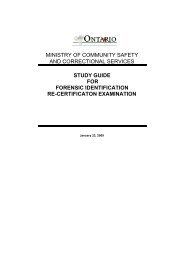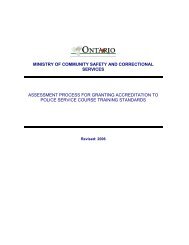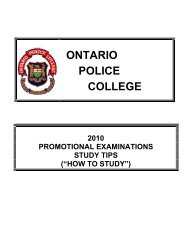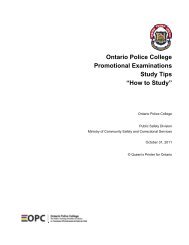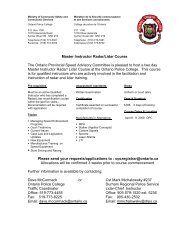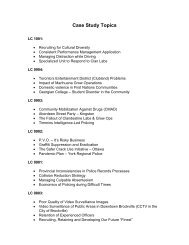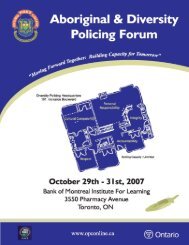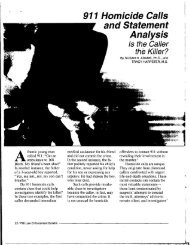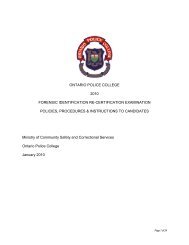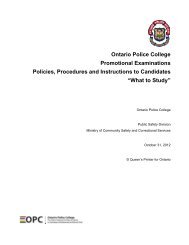General Study Guide - Ontario Police College
General Study Guide - Ontario Police College
General Study Guide - Ontario Police College
Create successful ePaper yourself
Turn your PDF publications into a flip-book with our unique Google optimized e-Paper software.
History of Fingerprint Identification<br />
Early Pioneers:<br />
Alphonse Bertillon – (April 22 or 23, 1853-Feb. 13, 1914)<br />
Alphonse Bertillon, working in the dungeon like halls of the identification bureau of the Paris<br />
Prefecture of <strong>Police</strong>, devised a meticulous method of measuring body parts as a means of<br />
identification, known as ‘The Bertillon Method of Identification’, ‘Bertillonage’ or ‘Anthropometry’.<br />
It was first used in 1883 and was found to be slightly flawed in 1903 (known as the Will West Case).<br />
The West case didn’t end the use of Anthropometry but it did establish that Anthropometry didn’t<br />
individualize all people. Even though the Bertillon system didn’t provide perfect results, it did<br />
provide sufficient results and was very useful in its day. It was accepted as the world’s first scientific<br />
method of criminal identification.<br />
Bertillon is also credited with solving the first crime involving latent prints without having a suspect.<br />
Bertillon identified latent prints found on a piece of glass, from the murder scene of Joseph Reibel,<br />
as being left by Henri Leon Scheffer's. Bertillon found the identification by searching his files one<br />
person at a time. The date of the murder was October 17, 1902 and the identification was made on<br />
October 24, 1902. This is published in "Alphonse Bertillon: Father of Scientific Detection", Henry<br />
Rhodes (1956).<br />
William Herschel – came from an eminent scientific family. Both his father and grandfather were<br />
astronomers. He started researching fingerprints as early as 1858. His research only focused,<br />
however, on fingerprint permanency over a lifetime. Herschel used fingerprints as ‘signatures’ on<br />
contracts and jail sentencing documents and any opportunity to prevent fraud in India.<br />
Dr.Henry Faulds – In 1878 he discovered fingerprints on ancient pottery in Japan and began his<br />
extensive fingerprint research in both permanency and uniqueness. In Oct.1880 he was the 1st<br />
individual to publicly suggest using fingerprints for solving crime. In 1886 he tried to convince<br />
Scotland Yard to adopt the fingerprint system.<br />
Sir Francis Galton – A famous scientist, Galton’s most interesting contribution to the science of<br />
friction ridge identification was his method of distinguishing fingerprints having the same general<br />
pattern. He noticed that ridges did not proceed in unbroken lines across the finger but rather<br />
stopped abruptly, split, formed enclosures or connected with other ridges. These types of ridge<br />
characteristics are referred to as ‘Galton points’ still today. He used this comparison of ridge detail<br />
to confirm Herschel’s observations of fingerprint permanence. He published his book Finger Prints<br />
in 1892 and provided the systematic proof for the scientific basis of fingerprint identification which<br />
contributed to its general acceptance.<br />
Sir Edward Henry – In 1883, working as Chief of <strong>Police</strong> in India, he added thumbprints to<br />
anthropometric cards. He was given credit for coming up with a comprehensive system for<br />
fingerprint classification that is still used today.



